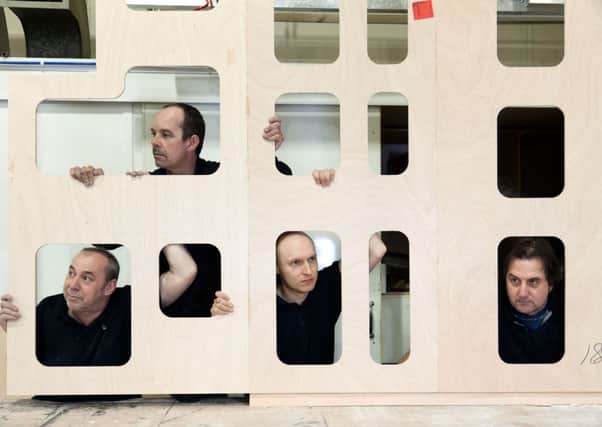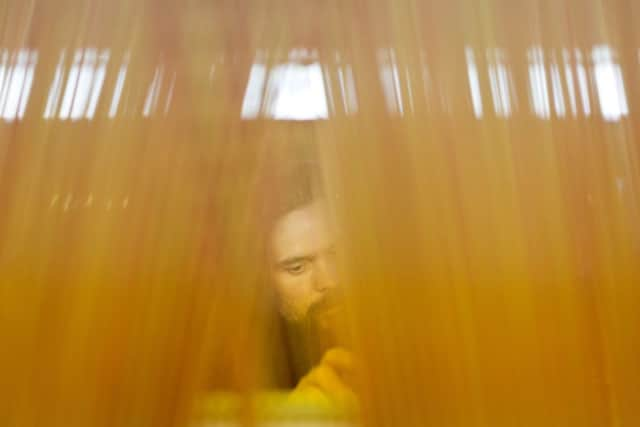Industrial resolution!


When Jonas Bendiksen embarked on a commission to capture life inside West Yorkshire’s textile industry there was almost an unintended consequence. The Magnum photographer came close, very close, to being dyed an attractive shade of navy blue.
“Ah yes, I nearly fell in a giant dyeing vat,” says the award-winning Norwegian photographer. “Despite repeated warnings from the guy who was manning the machine not to step too close, I, well, stepped too close. I didn’t see one of the grilles on the floor was open and I very nearly went right through it.”
Advertisement
Hide AdAdvertisement
Hide AdDisaster averted, Bendiksen continued his odyssey which took him to the likes of luxury wool manufacturer Abraham Moon and Sons in Guiseley, Leeds bedmakers Harrison Spinks and Bradford wool suppliers Texere Yarns. He admits he was unsure about taking on the project, fearing that the rise of new technology would have stripped the colour and silenced the beating heart of many of the old industries.


“I accepted the commission from the National Media Museum not because I had anything particular to say about the topic or because I had much prior knowledge, but because I like getting into new situations, places I have to explore from scratch. The only thing I knew was that this area was the birthplace of the Industrial Revolution, it probably didn’t look good any more and a part of me was very apprehensive.
“It is often a huge challenge to photograph industry and manufacturing. The facilities these days are often incredibly sterile, the machinery automatic and more and more the human interaction within the various process has disappeared.
“Technology is so good these days, it has streamlined so many operations. You put raw material in one end, it goes through a box and comes out finished. All you have is a guy watching a computer and that’s not great fun to photograph.”
Advertisement
Hide AdAdvertisement
Hide AdAround the country eight other photographers from the renowned Magnum agency, each commissioned by a different organisation, were exploring other industries from one-man businesses to FTSE 100 companies. Martin Parr’s collection took him from a billiard cloth maker to a bespoke bicycle manufacturer, Chris Steele Perkins photographed those behind the construction of luxury yachts and recycled tyres and when Bendiksen walked into William Halstead, the Bradford weaving company which first opened in 1875, he admits he left any fears he had at the front door.
“As soon as I saw the first mill I quickly realised that all my preconceptions were wrong. I’d imagined a clean, almost empty room wherever everything was controlled by computers. Here was the total opposite. It was much more human. It was like manufacturing used to look like.
“It was a place filled with history, both in terms of the people, many of whom have worked their whole lives in the mills, but also in the machinery, the architecture and the actual process of turning the raw product into material.
“There are still cogs and springs bouncing up and down and it is much more mechanical than I ever imagined. Because of that, it’s also fallible and when things go wrong it was just as fascinating watching the guys whose job it is to step in, fix the problem and get everything going again. Honestly, that was beautiful.”
Advertisement
Hide AdAdvertisement
Hide AdOpen For Business is currently on display at the National Media Museum in Bradford and the project hopes to capture British manufacturing’s effect on culture and community life, and celebrate the working lives of its employees. However, much of the work also reveals the daily struggle to stay in business.
Elsewhere York’s National Railway Museum asked Mark Power to capture the country’s ever-evolving transport industry with particular focus on Derby-based Bombardier, which suffered significant staff cuts after it lost the Thameslink contract to Siemens in 2011.
“I perhaps made a mistake by beginning my project with a visit to the museum’s extraordinary photographic archive to see the dramatic images for the Derby Railway Works dating from the late 19th century. Of course, I knew the modern Bombardier site would look nothing like the world portrayed in those wonderful documents There are no steelworks belching out dramatic black smoke, no workers doused in soot. It’s a clean, tidy assembly line producing on average one train per day with parts arriving from all over the world.
“Rather than trying to describe exactly what they do there now I concentrated instead on tiny details, flash-lit pictures of human effort, concentration and skill.”
Advertisement
Hide AdAdvertisement
Hide AdBack in West Yorkshire, Bendiksen decided to make a video to sit alongside his collection of still photography.
“The machines have their own rhythm and choreography and that’s why I wanted to record some footage. When you watch the needles on the weaving machine you can’t help but think back to the Industrial Revolution. That’s what I wanted to explore. Through these photographs I wanted to show how the contemporary connects to the archaic and how the automatic connects to the human.
“There are so many products that we have no idea what or who’s behind them and this was a chance to look behind the scenes and show an industry at work.”
Open for Business, National Media Museum, Bradford, to May. For more information go to www.openforbusiness.uk.com or for a behind-the-scenes look openforbusiness-uk.tumblr.com